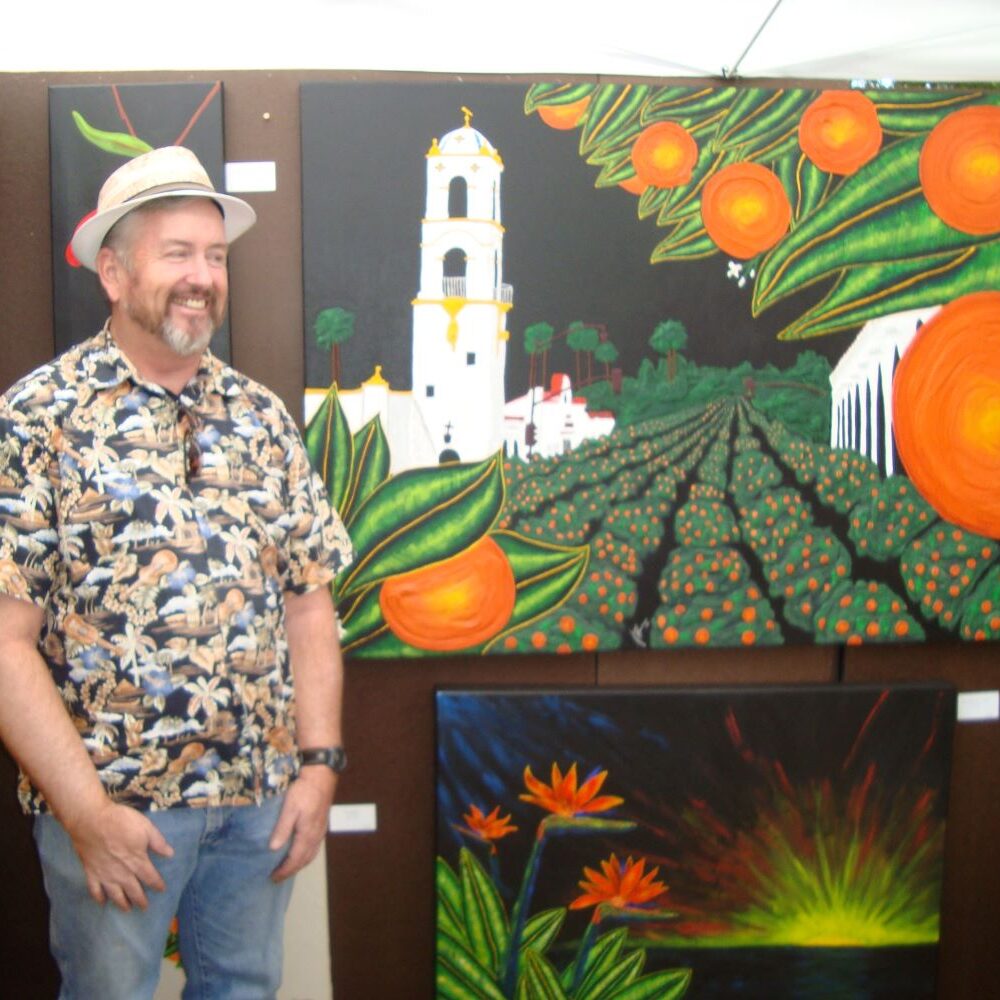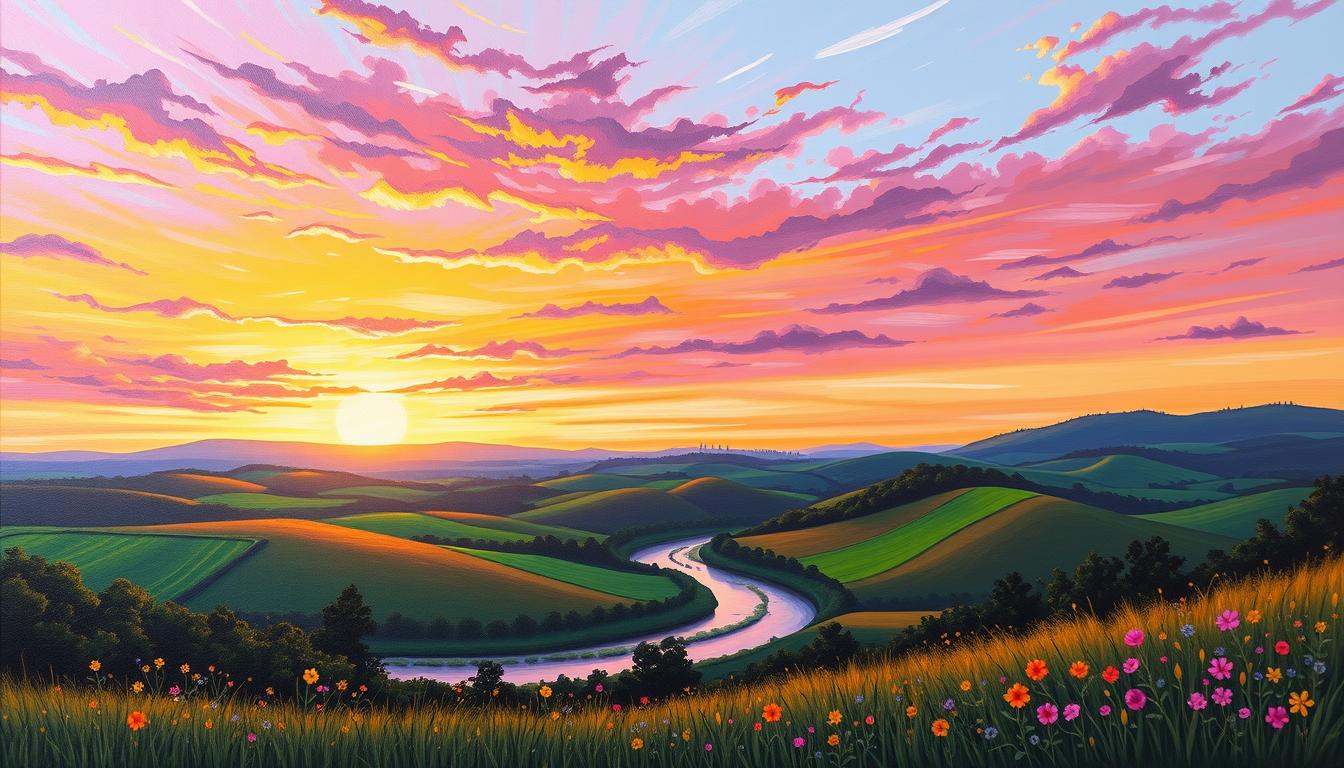This post contains affiliate links.
I’ve always been drawn to nature’s beauty. The way light moves across a field and the calm of a distant view fascinate me. Painting landscapes has been my passion for years. Acrylic paints have become my go-to for capturing nature’s wonders.
They offer vibrant colors and versatility, making them perfect for outdoor scenes. In this guide, we’ll explore acrylic landscape painting. We’ll cover techniques and strategies to help you create stunning pieces. This article is for both seasoned artists and beginners looking to improve their skills.
Key Takeaways
- Acrylics are quick-drying and versatile, great for dynamic layering and easy fixes.
- Try a wide range of acrylic colors, including metallic and iridescent, to capture nature’s details.
- Invest in quality brushes and a simple color palette to enhance your paintings.
- Learn underpainting and layering to add depth and texture to your landscapes.
- Experiment with impasto and glazing to add interest and depth to your work.
Mastering the Basics of Acrylic Landscape Painting
Before starting your acrylic landscape painting, it’s key to prepare. Begin by sketching your idea on paper. This step helps you plan your composition and find your focal point. It also helps you avoid mistakes.
With a solid sketch, you’ll know exactly what landscape you want to paint.
Choose the Right Brushes
Choosing the right brushes is crucial for acrylic landscape painting. Use flat or filbert brushes in different sizes for various textures. A fan brush is also great for painting foliage and trees.
Create a Color Palette
Creating a thoughtful color palette is vital in acrylic painting. It sets the tone and mood of your artwork. A well-chosen color scheme can deeply affect how viewers feel and see your painting.
Using a few colors can also help you improve your technique. It lets you focus on mixing and layering colors.
“A well-planned color palette can control the mood, atmosphere, and emotion of your painting, which can profoundly influence the viewer’s interpretation and experience.”
Mastering acrylic landscape painting starts with a solid foundation. This includes sketching, choosing the right brushes, and creating a color palette. With these basics, you’ll be ready to create stunning landscapes that captivate your audience.
Underpainting: The Foundation of Your Landscape
In the world of acrylic painting, underpainting is key. It sets the stage for your amazing landscape art. This first layer is thin and loose, making a base for your work. It adds depth, texture, and color.
Many acrylic painters start with an underpainting. It lets them play with the medium’s colors and vibrancy. The colors used can be warm or cool, based on your vision. These tones will show through the final layers, enriching your art.
Some artists choose to show parts of the underpainting. This creates a striking contrast that adds interest. Using monochromatic or dark colors like burnt sienna can lead to amazing results.
Gillian Hebblewhite’s work is a great example. She completed a landscape painting over a black background. She was unsure at first but loved the final result. It shows the depth and versatility of underpainting in acrylic art.
Whether you’re new or experienced, learning underpainting is vital. It opens up new creative paths. It helps you bring your vision to life in beautiful ways.

Painting in Layers: From Background to Foreground
Creating stunning acrylic landscape paintings starts with layering paint. This method adds depth and realism to your work. It makes your art more engaging and lifelike.
Begin with the background, like the sky and far-off landscapes. Set the tone and values first. Then, move to the foreground, focusing on details, texture, and contrast. The foreground should grab the viewer’s eye, while the background fades into a soft blur.
This layering technique brings depth and perspective to your art. Far-off objects seem less vivid and less detailed. Closer elements, however, pop with color and clarity. Acrylic paint is great for this because it blends smoothly and builds up colors well.
| Painting Layer | Considerations |
|---|---|
| Background | Establish the overall tone, values, and horizon line |
| Midground | Gradually introduce more detail and contrast |
| Foreground | Focus on the closest elements with the highest level of detail and contrast |
Mastering layering in acrylic painting can take your landscapes to the next level. Start with broad strokes and refine details as you move forward. This will create a captivating depth that pulls the viewer in.
“Painting is the art of conveying ideas and emotions through the strategic use of color, brushstrokes, and composition. The layering technique is a powerful tool in the acrylic painter’s arsenal.”
Advanced Techniques for Acrylic Landscape Painting
As you get better at acrylic landscape painting, trying out advanced techniques can really boost your art. Two key techniques are impasto and glazing. They help add depth, texture, and light to your paintings.
Impasto: Adding Texture and Depth
Impasto means using thick paint to make your art feel three-dimensional. It’s great for showing off nature’s beauty, like the green leaves of trees or the bright colors of flowers. Use a palette knife, sponges, or other tools to create bold strokes and layers of paint. This will make your landscapes feel real and touchable.
Glazing: Creating Luminous Effects
Glazing lets you mix colors and add depth to your art. It involves putting thin, clear layers of paint over a dry base. This makes your paintings look bright and deep. Use a small brush to apply these layers carefully, so the colors underneath show through.
Learning these advanced techniques will help you make your acrylic landscapes come alive. They will grab the viewer’s attention with their texture, depth, and light. Get creative with acrylics and watch your art grow!

The Art of Wet-on-Wet Painting
Acrylic painting techniques like wet-on-wet can change the game for stunning landscapes. This method involves adding wet paint to a wet surface. It lets colors blend and soften, capturing nature’s ethereal qualities.
The wet-on-wet technique is great for painting things like clouds, water, and soft features. It lets artists achieve a captivating, atmospheric effect. This adds depth and realism to their acrylic landscape paintings.
This technique is also good for creating depth and distance in paintings. Wet paint on a wet surface blends and softens colors. It makes scenes look hazy and far away. It’s perfect for plein air painting, capturing the outdoor environment in real-time.
Artists like John Singer Sargent and Pro Hart have mastered this technique. They’ve created stunning, atmospheric landscapes. These paintings capture the scene’s energy and movement, letting viewers feel it.
Whether you’re new or experienced in acrylic painting, trying wet-on-wet can be exciting. It opens up new creative possibilities. By experimenting with brushwork and paint, you can express yourself in new ways in your landscape paintings.
Negative Painting: Carving Out the Subject
In the world of acrylic painting techniques, negative painting is a fascinating method. It involves painting around a subject to create it, not directly. This technique uses contrasting values to make shapes stand out in a unique way.
Negative painting gives artists control over their landscape painting ideas. It helps in creating depth, balance, and interest. These elements can be hard to achieve with traditional painting.
The process starts with experimenting with colors, textures, and paint layers. It leads to a meditative state. Here, artists focus on shapes, values, and edges, not just the subject.
“Negative painting is a powerful technique that allows me to carve out the essence of a landscape, bringing a sense of depth and drama to my work. It’s a process that encourages me to think beyond the obvious and explore the hidden shapes and forms that give a scene its character.”
Whether you’re new or experienced, negative painting can change your acrylic painting techniques. It opens up new creative paths and deepens your understanding of landscape painting.
Negative painting works with many art forms and mediums, like acrylics and pastels. It helps artists grow their skills and find new ways to engage their audience.
Acrylic Landscape Painting Tips: Enhance Your Art
Mastering acrylic landscape painting involves several key tips. These acrylic painting techniques and landscape painting ideas can inspire you. They help you create stunning artworks.
Understanding the four planes of the landscape is crucial. These are sky, ground, slanted, and upright. Use different tones of grey to block in these planes. Start with the lightest for the sky and the darkest for the upright elements.
Choosing the right brushes and palette knives is also key. Quality tools help you achieve the textures and brushstrokes you want. A round brush is great for blending, while a square brush works well for the sky and sharp details.
Color is vital in your landscape painting ideas. Notice how colors change with time, weather, and light. Use a mix of pure hues and muted tones to add depth and atmosphere.
Try techniques like underpainting and atmospheric perspective. Underpainting sets the color and value foundation. Atmospheric perspective uses color and detail to suggest distance, adding depth and space.
Practice and exploration are key to improving your acrylic landscape painting skills. Study famous landscape artists and observe nature. With these tips, you’ll create acrylic landscape paintings that inspire and delight.
Composition: The Key to Captivating Landscapes
In landscape painting, composition is key to a captivating work. It’s essential for artists to master composition to impress their audience. Finding the focal point and using contrast are crucial steps.
Finding Your Focal Point
A focal point draws the viewer’s eye and balances your painting. A majestic mountain, a winding river, or a striking tree can be your focal point. These elements guide the viewer’s gaze, creating a captivating composition.
Utilizing Contrast
Contrast is a powerful tool for landscape painters. It adds depth, drama, and excitement to your work. For example, a smooth background can contrast with a textured foreground, drawing the viewer in.
FAQ
What are some basic tips for acrylic landscape painting?
How do I use underpainting in acrylic landscape painting?
What are some advanced techniques for acrylic landscape painting?
How do I create a successful composition in an acrylic landscape painting?
This post contains affiliate links.

